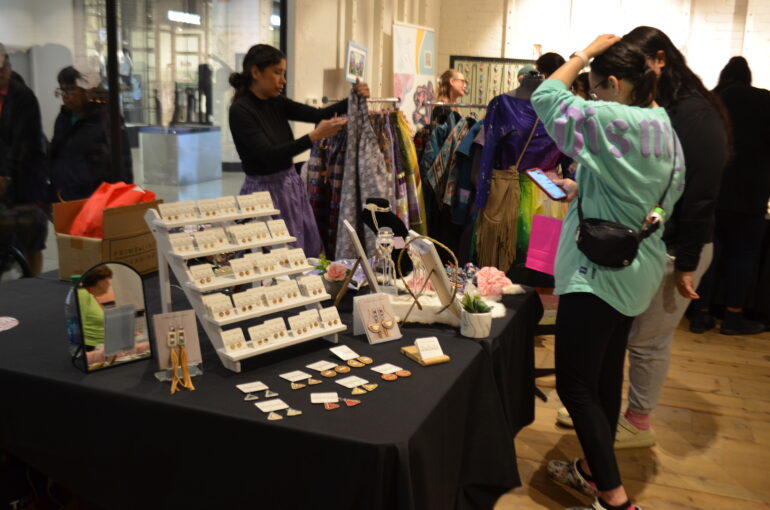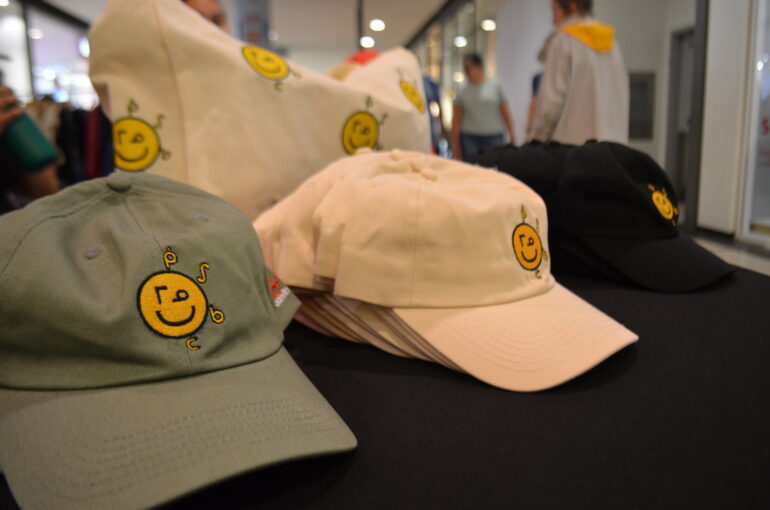The CF Eaton Centre showcased Indigenous artists at the fourth annual Indigenous Fashion Arts (IFA) Festival.
From May 3 to June 2, the Eaton Centre displayed fashions from Indigenous artists worldwide, shedding light on the creativity of Indigenous artists.

Mallgoers were able to see a variety of clothing, jewelry, and shoes made by Indigenous artists. Photo credit: Ciara Lalor-Lindo
The event’s marketplace exhibited over 75 vendors with various mediums like beadwork, weaving, metalwork, and more.
Chanin Payea, half of the mother-daughter duo Two Hearts Beadwork, utilizes materials organic to the Indigenous culture like porcupine quills and bones, and discussed the importance of having their art shown on a large scale.
“To be in a spot where so many non-Indigenous people are walking around and have them say ‘oh, what’s going on here?’ is important for people to see that we’re still here and innovative,” Payea said.
Payea’s mother and the other half of Two Hearts Beadwork, Jasmine Girard, seconded her daughter’s thoughts, happy their art could be seen.
“Everyone here seems to appreciate our art, and sometimes we don’t always get that spotlight,” Girard said.
This event kick-started Indigenous History Month, a time when non-Indigenous people can honour the achievements, innovations, and resilience of Indigenous peoples.
While acknowledging the work of Indigenous peoples should be year-round, many non-Indigenous do not actively seek out Indigenous art, which is why events like the IFA Festival are crucial, said Payea.
“We’re still here, we’re still creating,” Payea said. “We’re with, and often ahead of, the times.”
For many of these artists, showing their work in the Eaton Centre goes beyond promoting a brand, but sharing history.
Stephanie Peltier, First Nation Ojibwe member of Wiikwemikoong Unceded Territory on Manitoulin Island, and owner of Deliaestelle Designs, said her art is focused on storytelling, allowing others to participate is crucial for understanding Indigenous history.
“My art has a lot of storytelling in terms of the materials that I use,” Peltier said. “I like to share my story by providing workshops with the help of my beginner beading kits where you can create your pair of earrings,”
Having Indigenous art that is easily accessible goes further than supporting an artist, but is necessary for the progression of acknowledgment and reconciliation.
“It’s giving visibility to Indigenous peoples to see their capacity and possibility of what we can provide in terms of creativity,” Peltier said.
Regarding Indigenous visibility, aanin, Canada’s first 100 per cent Indigenous retailer in the Stackt popup market at 28 Bathurst St., said integrating Indigenous culture allows non-Indigenous people to indulge in the culture without overstepping.
Rachel White, an intern, talks of the misunderstanding some non-Indigenous people may feel when wanting to support Indigenous art.
“I feel like there’s a lot of misconception when it comes to Indigenous and cultural stuff because people feel like they can’t wear it,” White said.

aanin shows non-Indigenous people that they can support and wear clothing by Indigenous artists. Photo credit: Ciara Lalor-Lindo
Aanin hopes to push Indigenous clothing to the mainstream, as they currently house 50 Indigenous brands with plans on expanding, said Raven Sutherland, aanin’s marketing and communications manager.
“I think within the next 10 years, we would want to get a permanent space in downtown Toronto,” Sutherland said. “We want to be like the mainstream retailers, like Hudson’s Bay, while giving back to the Indigenous economy.”
While some brands would like to gain mainstream recognition, others like hide tanner Meagan Anishinabie, would like to retain a sense of traditionalism.
“For the most part, I do everything myself so it takes a lot of time,” Anishinabie said. “Everything you see here is from animals that either we, our family, or community harvested and we take their skins and do traditional hide tanning.”
Doing this work is time-consuming but it allows for the examination of the need for Indigenous people to retain their culture and use what the land provides, Anishinabie said.
“It’s more than just fashion, it’s our way of life,” Anishinabie said. “It’s sustainability, it’s using what our land has to offer.”


